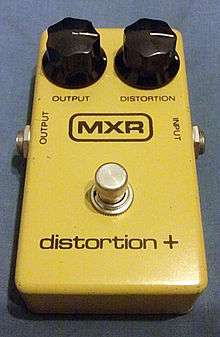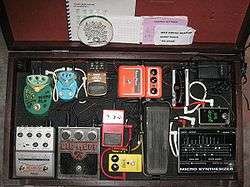MXR Distortion +
The MXR Distortion + ("Distortion Plus") is a distortion pedal originally designed in the 1970s by MXR Innovations. As its name implies "distortion," it's a 'distortion' (parallel clipping) but has a rather mild sound. It has been cloned many times, most famously by the DOD 250 Overdrive (a distortion). The pedal uses a single op-amp and a pair of germanium diodes to ground (parallel-push) for clipping in a very simple configuration with only Output and Distortion controls, no tone control; the pedal uses no discrete transistors. Turning up the Distortion control increases the amount of distortion and at the same time boosts the treble in the signal[1].


This pedal is perhaps best known for its crunchy heavy metal sound that was featured by Randy Rhoads in his work with Ozzy Osbourne[2]. Jerry Garcia of the Grateful Dead used this pedal exclusively for distortion in the late 1970s[2]. Bob Mould of Hüsker Dü also used the Distortion + as part of his trademark guitar sound[3]. Dave Murray of Iron Maiden has used Distortion + since the early 1980s[4]. Thom Yorke of Radiohead has included the Distortion + for many of his signature distortion sounds, using a variety of guitars to achieve various tonal options. Rowland S. Howard (The Birthday Party/These Immortal Souls/Crime & the City Solution/Solo albums) also used this pedal across his career.
References
- "ElectroSmash - MXR Distortion + Circuit Analysis". www.electrosmash.com. Retrieved 2020-01-17.
- Gill, Chris. "Out of the Box: Guitar World Celebrates the Time-Honored History of MXR Effect Pedals". Guitar World. Future plc. Retrieved 2018-07-31.
- Cochran, Kevin. "Gear Blog: Bob Mould". Austin City Limits. KLRU-TV, Austin PBS. Retrieved 2018-08-01.
- Bosso, Joe. "Iron Maiden: Out of Thin Air". Premier Guitar. Premier Guitar Magazine. p. 2. Retrieved 2018-07-31.